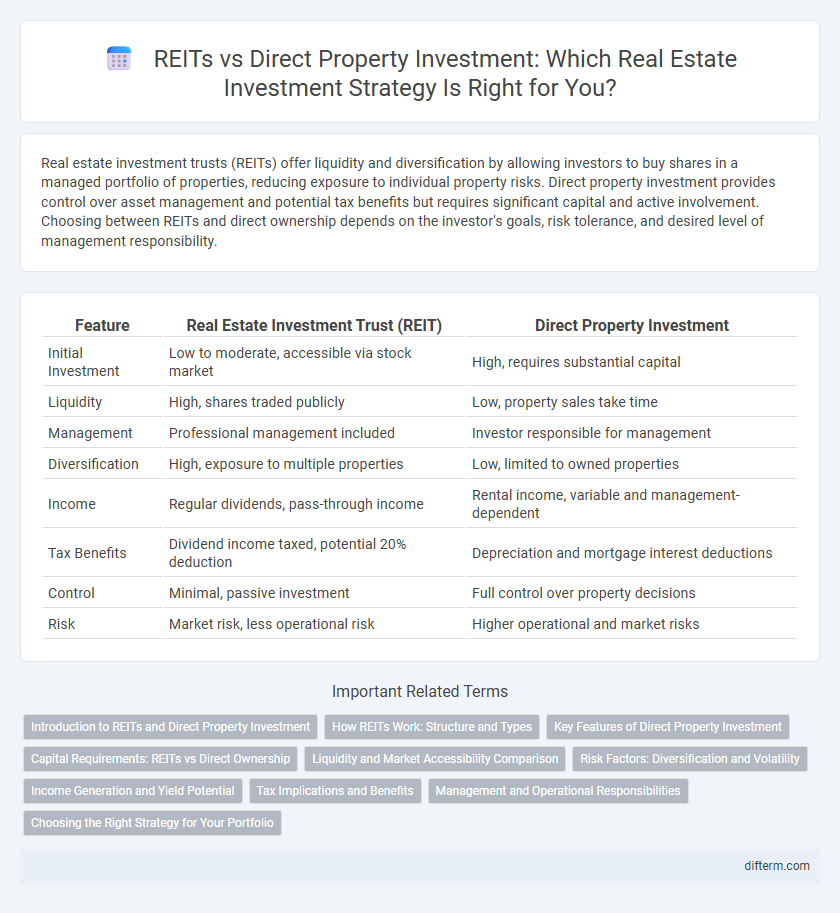Real estate investment trusts (REITs) offer liquidity and diversification by allowing investors to buy shares in a managed portfolio of properties, reducing exposure to individual property risks. Direct property investment provides control over asset management and potential tax benefits but requires significant capital and active involvement. Choosing between REITs and direct ownership depends on the investor's goals, risk tolerance, and desired level of management responsibility.
Table of Comparison
| Feature | Real Estate Investment Trust (REIT) | Direct Property Investment |
|---|---|---|
| Initial Investment | Low to moderate, accessible via stock market | High, requires substantial capital |
| Liquidity | High, shares traded publicly | Low, property sales take time |
| Management | Professional management included | Investor responsible for management |
| Diversification | High, exposure to multiple properties | Low, limited to owned properties |
| Income | Regular dividends, pass-through income | Rental income, variable and management-dependent |
| Tax Benefits | Dividend income taxed, potential 20% deduction | Depreciation and mortgage interest deductions |
| Control | Minimal, passive investment | Full control over property decisions |
| Risk | Market risk, less operational risk | Higher operational and market risks |
Introduction to REITs and Direct Property Investment
Real Estate Investment Trusts (REITs) offer a liquid, diversified way to invest in commercial properties through publicly traded shares, providing regular dividend income and professional management without the need to directly handle physical assets. Direct property investment involves purchasing individual real estate assets, offering greater control and potential tax benefits but requiring active management, higher capital, and exposure to market volatility and illiquidity. Comparing these two options, investors weigh factors such as risk tolerance, investment horizon, portfolio diversification, and desired involvement in property management.
How REITs Work: Structure and Types
Real Estate Investment Trusts (REITs) operate by pooling investor funds to acquire and manage income-producing properties, distributing most of their taxable income as dividends. Structured as publicly traded, public non-traded, or private entities, REITs offer diverse investment types including equity REITs, mortgage REITs, and hybrid REITs. Equity REITs primarily invest in physical real estate, mortgage REITs focus on real estate loans, while hybrid REITs combine both strategies to balance risk and return.
Key Features of Direct Property Investment
Direct property investment involves owning physical real estate assets, allowing for tangible control and customization of the property. Investors benefit from potential rental income, property appreciation, and tax advantages such as depreciation deductions. This form of investment requires substantial capital, active management, and carries risks related to liquidity and market fluctuations.
Capital Requirements: REITs vs Direct Ownership
Real estate investment trusts (REITs) require significantly lower capital compared to direct property ownership, enabling investors to diversify with smaller initial investments. Direct property investment demands substantial upfront capital for property acquisition, maintenance, and management, limiting accessibility for many investors. REITs offer liquidity and lower entry barriers, while direct ownership involves larger capital commitments and potential for higher control over assets.
Liquidity and Market Accessibility Comparison
Real Estate Investment Trusts (REITs) offer high liquidity by being traded on major stock exchanges, enabling investors to buy and sell shares quickly compared to direct property investments that require significant time for property transactions. Market accessibility is broader with REITs, allowing small investors to access diversified real estate portfolios without large capital, while direct property investment demands substantial funds and often complex legal procedures. This liquidity and ease of access make REITs more suitable for investors seeking flexibility and lower entry barriers in real estate markets.
Risk Factors: Diversification and Volatility
Real estate investment trusts (REITs) offer greater diversification by pooling a variety of property assets, which reduces the risk associated with individual property performance. Direct property investments carry higher volatility due to concentration in specific locations or property types, increasing exposure to market fluctuations and tenant risk. REITs also provide liquidity advantages, allowing investors to respond more quickly to market changes compared to the typically illiquid nature of direct property ownership.
Income Generation and Yield Potential
Real Estate Investment Trusts (REITs) offer investors liquidity and regular dividend income derived from a diversified portfolio of income-producing properties, often yielding 4-7% annually. Direct property investment typically requires larger capital but can provide higher yield potential through rental income and property appreciation, with yields varying widely by location and property type, often between 6-12%. REITs minimize management responsibilities and market volatility risk while direct ownership allows for greater control and opportunities for value-add strategies to boost income generation.
Tax Implications and Benefits
Real estate investment trusts (REITs) offer tax advantages such as avoiding double taxation, as income is typically distributed to shareholders and taxed at the individual level. Direct property investment allows for depreciation deductions and potential property tax benefits, providing investors with opportunities to reduce taxable income. However, direct ownership may incur higher capital gains taxes upon sale, whereas REIT dividends are generally taxed as ordinary income, influencing overall tax efficiency in each investment strategy.
Management and Operational Responsibilities
Real Estate Investment Trusts (REITs) offer a hands-off approach to property investment, as professional management teams handle acquisition, leasing, maintenance, and compliance, reducing operational burdens on investors. Direct property investment requires active involvement in property management tasks such as tenant relations, maintenance coordination, and regulatory compliance, demanding significant time and expertise. Investors seeking passive income often prefer REITs for streamlined management, while those desiring control and customization may opt for direct ownership despite the operational complexities.
Choosing the Right Strategy for Your Portfolio
Real Estate Investment Trusts (REITs) offer liquidity, diversification, and professional management, making them ideal for investors seeking passive income and exposure to commercial real estate markets without the complexities of property management. Direct property investment provides greater control, potential tax advantages, and the opportunity for property value appreciation through active management, but requires significant capital and operational involvement. Selecting the right strategy depends on your risk tolerance, investment horizon, and desire for hands-on involvement versus a more hands-off approach.
real estate investment trust (REIT) vs direct property investment Infographic

 difterm.com
difterm.com